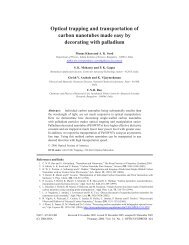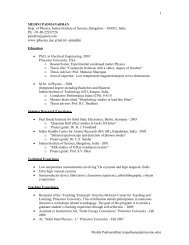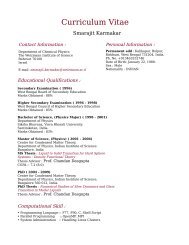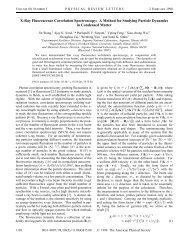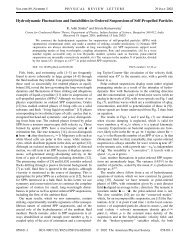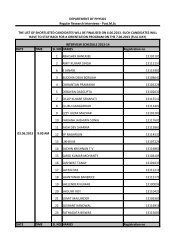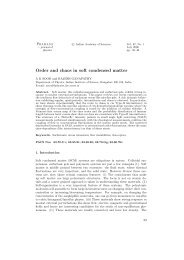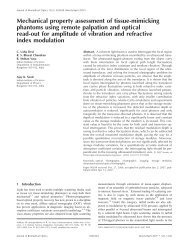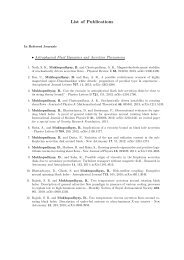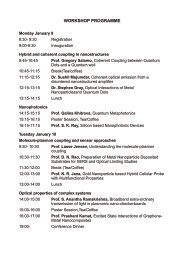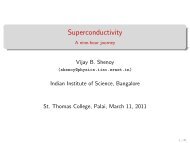Thermoelectric Properties of Fe0.2Co3.8Sb12-xTex ... - Physics
Thermoelectric Properties of Fe0.2Co3.8Sb12-xTex ... - Physics
Thermoelectric Properties of Fe0.2Co3.8Sb12-xTex ... - Physics
You also want an ePaper? Increase the reach of your titles
YUMPU automatically turns print PDFs into web optimized ePapers that Google loves.
Measurement <strong>of</strong> Proton-Carbon Dipolar Couplings using an<br />
improved DAPT pulse sequence<br />
R.V. Sudheer Kumar $, # and K.V. Ramanathan #<br />
Department <strong>of</strong> <strong>Physics</strong> $ , NMR research centre #<br />
Indian Institute <strong>of</strong> Science, Bangalore, India<br />
Dipolar couplings provide valuable information on order and dynamics <strong>of</strong> liquid crystals.<br />
Experiments to measure heteronuclear dipolar couplings are very powerful and widely<br />
important in solid state NMR, since it provides site specific dipolar couplings in aligned<br />
samples. Interpretation <strong>of</strong> these heteronuclear dipolar couplings are hampered by the<br />
chemical shift anisotropy (CSA) and dipolar interactions among abundant spins ( 1 H- 1 H<br />
couplings). Additionally, multiple 13 C- 1 H dipolar couplings found in complicated systems<br />
make the spectra more difficult to use. For static samples the complications are resolved<br />
partially by separated local field (SLF) spectroscopy where the local field due to<br />
heteronuclear dipolar coupling and chemical shift interactions are separated into two<br />
frequency domains in a 2D experiment. A method <strong>of</strong> separated local field experiment is<br />
presented for measuring heteronuclear dipolar couplings in oriented systems. This method is<br />
based on Dipolar assisted polarization transfer (DAPT). Compared to rotating frame<br />
techniques based on Hartmann-Hahn match, this approach is easy to implement and is<br />
independent <strong>of</strong> any matching condition. DAPT can be utilized either as a proton encoded<br />
local field (PELF) technique or as a separated local field (SLF) technique, which mean s that<br />
the heteronuclear dipolar coupling can be obtained by following either evolution <strong>of</strong> the<br />
abundant spin like proton (PELF) or that <strong>of</strong> the rare that <strong>of</strong> carbon (SLF).The DAPT pulse<br />
sequence has been improved for efficient homonuclear decoupling by the interpretation <strong>of</strong><br />
BLEW-48 pulse sequence. The implementations <strong>of</strong> the modified DAPT experiment both as a<br />
PELF and as SLF on oriented liquid crystalline samples have been carried out. The<br />
performance <strong>of</strong> this experiment is compared with PISEMA.



